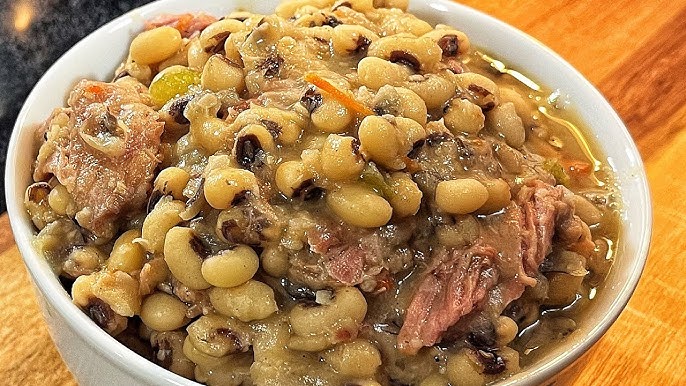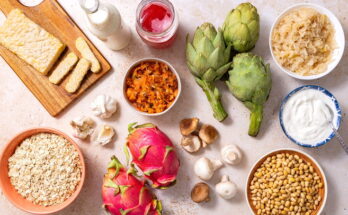Southern Black Eyed Peas Recipe: When it comes to soul food and Southern comfort, black eyed peas are the kind of dish that shows up in every potluck, New Year’s celebration, and Sunday family dinner across the South. They’re not just a meal—they’re a tradition. Rooted in African American culture, black eyed peas were brought to the American South during the transatlantic slave trade and have since become a symbol of prosperity and good luck. They’ve stood the test of time, evolving into a savory, hearty dish filled with history, flavor, and heart.
These legumes aren’t actually peas—they’re a variety of bean. But what they lack in taxonomy, they more than make up for in taste. Black eyed peas are loved for their slightly nutty flavor, firm texture, and how well they soak up spices and smoky flavors from meats like ham hocks, bacon, or sausage. Their ability to take on whatever seasoning you throw at them makes them a favorite in many kitchens.
But the real magic of Southern black eyed peas lies in their simplicity. A handful of ingredients, a good pot, and a little patience are all you need to create something truly delicious. Whether you’re honoring tradition or trying something new, this dish invites everyone to gather around and enjoy a bowl full of flavor and history.
Why This Dish Is a Must-Try
Why should you make black eyed peas at home? Simple: the flavor is unmatched. They’re savory, smoky, comforting, and rich in texture. On top of that, they’re incredibly affordable and packed with nutrition—high in fiber, protein, and essential nutrients like folate and magnesium.
More than that, making black eyed peas from scratch connects you to generations of cooks who relied on these humble beans to feed families, especially during tough times. There’s something deeply satisfying about turning a simple pot of beans into a mouthwatering meal that warms the soul.
Ingredients You’ll Need
Core Ingredients
To make a traditional pot of Southern black eyed peas, you only need a few simple ingredients. Most of these can be found at any grocery store, and once you have them all together, the dish practically cooks itself.
Here’s your essential shopping list:
- Dried black eyed peas – 1 pound (about 2 cups)
- Smoked ham hock or smoked turkey leg – Adds rich, smoky flavor
- Yellow onion – 1 large, finely chopped
- Garlic – 4 cloves, minced
- Celery – 2 ribs, diced
- Green bell pepper – 1, chopped
- Chicken broth or water – 6 to 8 cups
- Salt – to taste
- Black pepper – freshly ground
- Bay leaves – 2
This basic list gives you the foundation. With these ingredients, you’ll get that classic Southern flavor that’s been passed down through generations. The onion, garlic, and bell pepper create an aromatic base, while the smoked meat infuses the peas with an irresistible depth.
Optional Flavor Boosters
Want to level things up? Consider adding any of the following to make your peas sing:
- Bacon or salt pork – For even more porky goodness
- Crushed red pepper flakes – To add a touch of heat
- Fresh thyme or dried thyme – Brings out earthy notes
- A dash of hot sauce – For serving
- Apple cider vinegar – A splash right before serving brightens the dish
- Parsley or green onions – Chopped and added on top for freshness
Substitutes and Variations
If you don’t eat pork, you can easily make this dish with smoked turkey wings or legs. For a vegetarian version, omit the meat entirely and use smoked paprika, liquid smoke, or mushrooms to mimic that umami depth.
You can also swap the chicken broth for vegetable broth if you’re keeping it plant-based. And if you’re in a time crunch? Canned black eyed peas can work, but be aware—they’ll cook much faster and need less liquid.
Kitchen Tools You’ll Need
Cooking Equipment Checklist
While Southern cooking is all about heart and soul, having the right tools makes the process easier and more efficient. Here’s what you’ll need to get started:
- Large heavy-bottomed pot or Dutch oven – Essential for slow simmering and even cooking
- Cutting board and sharp knife – For chopping your aromatics
- Wooden spoon – Great for stirring and scraping up the good bits at the bottom of the pot
- Measuring cups and spoons – To get those seasonings just right
- Colander or sieve – For rinsing the peas
If you prefer a hands-off approach, a slow cooker or Instant Pot works wonderfully for this recipe too.
Prepping Essentials
Don’t overlook these small steps:
- Soaking bowl – If you’re soaking your peas overnight
- Storage containers – For leftovers
- Tasting spoon – You’ll want to check the flavor as it cooks
Having everything ready ahead of time not only speeds things up but also helps avoid kitchen chaos—especially when you’re juggling hot pans and bubbling pots.
Preparation Tips Before You Start
Soaking the Peas: Yes or No?
One of the most common questions is whether or not to soak the black eyed peas. The answer? It depends.
Soaking overnight:
- Reduces cooking time by about 30–40%
- Helps the peas cook more evenly
- Can make them easier to digest
To soak, simply cover your dried peas with water (about 2 inches above the beans) and let them sit overnight. Rinse them thoroughly before cooking.
No soak method:
- Totally acceptable for black eyed peas, which are softer than many other legumes
- Just be sure to add a bit more liquid and cook longer (up to 2 hours)
Soaking is not mandatory, but it does help if you’re short on time or want more control over the texture.
Prepping the Meat and Veggies
Get all your chopping and slicing done before turning on the stove. Dice your onions, mince the garlic, and slice the celery and bell pepper. If using bacon or salt pork, chop it into bite-sized pieces.
For smoked meats like ham hocks or turkey legs, there’s no need to chop them before cooking—they’ll fall apart beautifully as the peas simmer and the meat gets tender. Just make sure to inspect the meat for any unwanted bone fragments or skin.
Step-by-Step Guide to Making Southern Black Eyed Peas
Step 1 – Rinse and Sort the Peas
Start by sorting through your dried black eyed peas to remove any tiny stones or shriveled beans. Then give them a good rinse under cold water in a colander.
This might seem like a throwaway step, but it’s important. Nothing ruins a good bowl of peas faster than a hidden pebble or funky bean. Take your time and do it right.
Step 2 – Sauté Aromatics and Meats
Place your pot over medium heat and add a little oil or fat (bacon grease is gold here). Sauté the onions, celery, and bell pepper until they start to soften, about 5 minutes. Add the garlic last and cook for 1–2 minutes, just until fragrant.
If you’re using bacon or salt pork, toss it in now and let it render out until crispy. For a meatier flavor, sear the smoked ham hock or turkey leg briefly to get a little color on it—it deepens the flavor.
Step 3 – Add Peas, Liquids, and Seasonings
Once your aromatics are soft and your meat is nicely seared or bacon is crispy, it’s time to build the base of your black eyed peas.
Pour in the rinsed black eyed peas and stir them into the mixture to let them absorb a little flavor. Next, add 6 to 8 cups of chicken broth or water—enough to cover the peas by at least 2 inches. If you’re using a smoked ham hock or turkey leg, make sure it’s submerged as well.
Then, toss in your bay leaves, a few cracks of black pepper, and any additional spices you’re using—thyme, red pepper flakes, or a pinch of smoked paprika if you’re going for that extra depth. Hold off on adding salt until the end, especially if you’re using salty meats or broth. You can always add more later, but you can’t take it out.
Bring everything to a boil over medium-high heat, then reduce the heat to low, cover the pot, and let it simmer gently. This is when the magic happens.
Step 4 – Simmer Slowly for Rich Flavor
Simmering is the soul of this dish. The low and slow method allows the peas to absorb every ounce of smoky, savory goodness from the broth and meats. It also gives the meat time to become fork-tender and infuse the whole pot with flavor.
Let the pot simmer for about 1.5 to 2 hours, checking occasionally. Stir gently to keep things from sticking to the bottom. If the liquid level gets too low, add a bit more broth or water.
During this time, the black eyed peas will soften and plump up. You’ll start to smell that delicious aroma wafting through your kitchen—smoky, savory, and rich. It’s a signal that something special is on the way.
Once the peas are tender but not mushy and the meat is falling apart, you’re nearly done. If you want to thicken the pot liquor (the rich, flavorful broth), mash a small handful of peas against the side of the pot and stir them back in. This gives it a creamier texture without needing any added thickeners.
Step 5 – Final Seasoning and Serve
The final step is all about tasting and tweaking. Remove the bay leaves and take out the ham hock or turkey leg. If there’s a lot of meat on the bone, shred it and stir it back into the pot.
Now, taste your peas. Does it need more salt? A splash of vinegar to brighten things up? A dash of hot sauce for heat? Adjust as needed and give it another few minutes to marry those last flavors.
Once it’s perfect, ladle the peas into bowls and serve hot. Sprinkle with chopped green onions or parsley for a pop of color and freshness. Add a side of cornbread, rice, or collard greens—and you’ve got yourself a full Southern feast.
This is the kind of meal that tastes even better the next day, after all those flavors have had more time to come together.
What to Serve With Black Eyed Peas
Traditional Southern Pairings
Southern black eyed peas are delicious on their own, but they shine even brighter with the right sides. Here are the classics:
- Cornbread – The perfect partner, ideal for soaking up the flavorful broth
- Collard Greens – Adds bitterness and depth that balances the peas
- Fried Chicken – For a truly soul-satisfying Southern meal
- Steamed White Rice – A simple base to make the peas more filling
- Cabbage – Another New Year’s tradition, symbolizing prosperity
This trio—black eyed peas, greens, and cornbread—is often served on New Year’s Day to bring luck (peas), wealth (greens), and gold (cornbread) for the year ahead.
Modern Twists to Try
Looking to mix it up? Try these modern pairings or creative spins:
- Serve over quinoa or farro instead of rice for a healthier grain option
- Top with a poached or fried egg for a hearty breakfast-style twist
- Use leftovers in tacos or wraps with greens and hot sauce
- Make a black eyed pea stew by adding tomatoes and extra broth
Black eyed peas are incredibly versatile, so don’t be afraid to get creative with how you serve them!
Storing and Reheating Leftovers
Refrigeration Tips
Once your pot of Southern black eyed peas has cooled down to room temperature, it’s time to store the leftovers—if there are any! Properly storing black eyed peas helps retain their flavor and texture while preventing spoilage.
Use airtight containers, preferably glass or BPA-free plastic, and transfer the peas along with their broth. Keep in mind that storing them with the pot liquor (the flavorful liquid) helps preserve moisture and enhances the flavor when reheated.
Store the container in the refrigerator for up to 5 days. Make sure it’s sealed tight to keep out other fridge odors and to lock in freshness. Label your container with the date so you know when they need to be used by.
The flavors often intensify after a day or two, which makes the leftovers arguably even better. In fact, many people make black eyed peas ahead of time for this very reason.
Freezing for Later
If you want to save your black eyed peas for another time, freezing is a great option. Allow them to cool completely, then portion them into freezer-safe bags or containers. Remove as much air as possible to prevent freezer burn.
Pro tip: Freeze in individual portions, so you can easily defrost only what you need. Label with the name and date, and store in the freezer for up to 3 months.
To reheat, thaw in the refrigerator overnight and warm gently on the stovetop or in the microwave. Add a splash of broth or water to loosen the consistency if needed.
Avoid refreezing once thawed to preserve the taste and texture. And always reheat to a safe internal temperature—about 165°F.
Common Mistakes to Avoid
Overcooking vs. Undercooking
Like any great recipe, cooking black eyed peas has its pitfalls. The two biggest mistakes? Overcooking and undercooking.
Overcooking leads to mushy, broken-down peas that lose their structure and can become bland. This often happens when the heat is too high or they’re left simmering too long without supervision.
Undercooking, on the other hand, results in peas that are too firm or chalky in the center—a clear sign they weren’t simmered long enough or didn’t absorb enough liquid.
To hit that sweet spot, simmer them gently on low heat, check them around the 1-hour mark, and continue until they’re soft but not falling apart. Stir occasionally to avoid sticking and burning.
Flavor Flops and How to Fix Them
Sometimes, despite your best effort, the peas turn out bland or overly salty. Here’s how to recover:
- Too bland? Add more aromatics like sautéed garlic or onions. A splash of vinegar, lemon juice, or hot sauce can bring dull peas to life.
- Too salty? Add a peeled potato during cooking to absorb some salt (then discard it). Or dilute the pot with more water or unsalted broth.
- Too watery? Mash a few peas against the pot to thicken it. Simmer uncovered to reduce the liquid.
- Too spicy? Stir in a spoonful of sour cream or serve with a starchy side to balance the heat.
Remember, seasoning should be layered. Taste as you go and adjust accordingly—don’t just throw in salt at the end.
Nutritional Value of Black Eyed Peas
Health Benefits
Southern black eyed peas aren’t just delicious—they’re packed with nutritional benefits that make them a smart addition to your weekly meals.
Here are some key benefits:
- High in Fiber – Promotes digestive health and helps you feel full longer
- Rich in Plant-Based Protein – Excellent for vegetarians or anyone cutting back on meat
- Loaded with Folate and Iron – Crucial for red blood cell production and energy
- Low in Fat – Naturally low in fat, especially when made without added meats
- Supports Heart Health – Contains potassium and magnesium, which regulate blood pressure
Plus, they have a low glycemic index, making them a good option for people managing blood sugar levels.
Nutritional Breakdown Table (Per 1-cup cooked, without meat)
| Nutrient | Amount |
|---|---|
| Calories | 160 |
| Protein | 12g |
| Total Fat | 0.5g |
| Carbohydrates | 35g |
| Dietary Fiber | 11g |
| Sugars | 4g |
| Iron | 2.2mg (12%) |
| Folate | 358mcg (90%) |
| Potassium | 475mg |
| Magnesium | 45mg |
Percent daily values based on a 2,000-calorie diet.
With all those nutrients in one humble bean, you can see why black eyed peas are more than just soul food—they’re good-for-you food.
History and Cultural Significance
Black Eyed Peas in African American Cuisine
The story of black eyed peas is deeply interwoven with the African American experience in the United States. These humble legumes were originally brought from West Africa during the transatlantic slave trade and quickly became a dietary staple on Southern plantations. Enslaved Africans cultivated them not just for sustenance, but also as a vital connection to their heritage.
Over time, black eyed peas evolved into one of the cornerstone ingredients in what is now known as soul food. They were easy to grow, cheap to buy, and could be turned into a hearty meal with just a few ingredients—traits that made them invaluable to communities that had to make the most out of very little.
In African American households, the dish became more than just food—it was a symbol of resilience, resourcefulness, and community. It was shared at gatherings, after church services, and especially during holidays, becoming a culinary ritual that brought people together. The deep, smoky flavor and humble origins continue to reflect the strength and creativity of the Black community in America.
New Year’s Good Luck Tradition
If you’ve ever spent New Year’s Day in the South, chances are you’ve been offered a bowl of black eyed peas. This tradition has become almost sacred in many households, tied to a superstition that dates back to the Civil War.
According to Southern folklore, eating black eyed peas on January 1st brings good luck and prosperity for the year ahead. The peas themselves represent coins, symbolizing wealth. Pair them with collard greens (symbolizing money) and cornbread (representing gold), and you’ve got yourself a full plate of fortune.
One variation of the tradition includes cooking the peas with a coin or a piece of pork fat, and whoever finds it in their bowl is said to receive an extra dose of luck.
Whether or not you believe in the superstition, the practice is more than a culinary custom—it’s a celebration of hope, abundance, and family. And honestly, starting the year with a comforting bowl of black eyed peas never sounds like a bad idea.
Reader Tips and Personal Twists
Shared Stories and Favorite Add-ins
Over the years, cooks across the South—and across the globe—have put their personal spin on black eyed peas. Some stick with the classic formula, while others experiment with modern ingredients or family traditions that give the dish a unique flair.
Here are a few tried-and-true tips and customizations shared by readers and home cooks:
- “I add a can of fire-roasted tomatoes for a smoky, tangy kick.”
- “My grandma always finished hers with a tablespoon of brown sugar—it added a touch of sweetness that balanced the salt.”
- “I throw in a few dashes of Worcestershire sauce for depth.”
- “Try cooking them with beef kielbasa instead of ham—it’s amazing!”
Some even turn their black eyed peas into soups, stews, or even patties by mixing in breadcrumbs and pan-frying them like fritters. The possibilities are endless.
Making It Your Own
The beauty of Southern black eyed peas is how adaptable the recipe is. Whether you’re cooking for one or for a crowd, you can customize everything from the spice level to the broth thickness.
Here’s how you can make this recipe truly your own:
- Go global – Add curry powder or coconut milk for a Caribbean twist
- Make it spicy – Toss in jalapeños or chipotle peppers in adobo
- Add more veggies – Stir in spinach, kale, or chopped tomatoes at the end
- Switch up the meat – Try smoked chicken thighs, sausage, or no meat at all
- Use fresh herbs – Top with chopped cilantro or dill for a fresh punch
The point isn’t to make it perfect—it’s to make it yours. And once you do, don’t be surprised if it becomes a staple in your kitchen too.
FAQs about Southern Black Eyed Peas Recipe
Can I make it vegetarian?
Yes! Skip the meat and use vegetable broth instead of chicken broth. For added depth, stir in a teaspoon of smoked paprika or a splash of liquid smoke to mimic that traditional smoky flavor.
How long do cooked black eyed peas last in the fridge?
Stored in an airtight container, they’ll last up to 5 days in the refrigerator. The flavor actually gets better after a day or two!
Can I cook this recipe in a slow cooker?
Absolutely. Add all ingredients to your slow cooker and cook on low for 6–8 hours or high for 3–4 hours, until the peas are tender and the meat is falling off the bone.
Are black eyed peas keto-friendly?
They contain some carbs, so they aren’t ideal for strict keto diets. However, they’re packed with fiber and protein, making them a smart choice for balanced eating.
What’s the best meat to use?
Smoked ham hock is the traditional choice for its rich, salty flavor. But you can also use smoked turkey, bacon, sausage, or go meatless—this recipe is flexible.
Conclusion
Southern black eyed peas are more than just a dish—they’re a legacy. They represent survival, community, and flavor that comes from generations of love and learning. Whether you’re honoring family tradition, ringing in the New Year, or just craving something soulful and hearty, this step-by-step guide gives you everything you need to make a perfect pot every time.
The ingredients are humble, but the results are extraordinary. Rich, smoky, tender, and full of depth—black eyed peas are the kind of dish that welcomes everyone to the table. So go ahead, simmer a batch, and taste a bit of Southern history in every bite.



